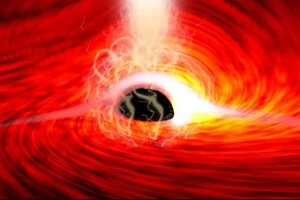Supermassive black holes appeared a billion years after the formation of the universe.

U.A.E. scientists were able to use a supercomputer solve one of the mysteries associated with the appearance of supermassive black holes. They were able to find out how these gigantic structures were able to form only a billion years after the Big Bang, reports Science Alert.
Black holes with a mass of billions of solar masses already existed in the “infancy” of our universe. Given everything that scientists know about the formation and growth of black holes, it is not easy to explain the existence of such giant structures.
Read also: Astronomers discovered a crater from a mysterious rocket that crashed into the Moon
Now, a simulation conducted with the help of a supercomputer has shown how supermassive black holes could form without the presence of exotic conditions. The simulation indicated the existence of reservoirs of turbulent, cold gas that collapsed into stars far more massive than anything currently in the universe. This was the “seed” from which supermassive black holes grew.
“Today, we find supermassive black holes in the centers of the most powerful galaxies, the mass of which can exceed the mass of the Sun by millions or billions of times. But in 2003, we began to detect quasars—extremely bright, actively accreting supermassive black holes, like cosmic beacons in the early universe that existed less than a billion years after the Big Bang. No one understood how they formed so quickly. This discovery is particularly interesting because it overturned 20-year-old ideas about the origin of the first supermassive black holes in the universe,” said cosmologist Daniel Whalen from the University of Portsmouth in Great Britain.
There are two main versions of the origin of black holes. According to the first of them, a massive star dies and leaves behind a black hole, the mass of which exceeds the mass of the Sun by about 100 times. Over time, the black hole absorbs a bunch of material, growing larger and larger until it is billions of times larger than our star. Such a process is difficult to reconcile with the existence of quasars in the early universe.
Another option is the immediate appearance of a giant black hole, the mass of which exceeds that of the Sun by 100,000 times. Stars that collapse to form such black holes have short lives, probably only 250,000 years, before dying.
But today nothing is known about the existence of such stars. There is no information about the formation mechanism that could lead to their appearance. However, simulations have shown that in the early universe, when conditions were different from today, such stars could form at the junctions of rare and powerful flows of dense, turbulent, cold gas.
Previously, cosmologists assumed that truly exotic conditions such as the strong ultraviolet background or supersonic flows between gas and dark matter. And none of these exotic conditions resembled the environment in which these early quasars of the universe were discovered.
But new simulations showed that supermassive black holes form at the intersection of such flows spontaneously, without the need for additional conditions. In the simulation, the turbulence created by the intersecting streams prevents the formation of ordinary stars like the ones we see today. This usually happens when a dense knot of material in a cold cloud collapses under the influence of gravity to form a young star, but when the turbulence is very high, conditions are not stable enough for this to happen.
However, eventually the cloud in the simulation became so massive that that catastrophically split into two giant stars, 31,000 and 40,000 times the mass of the Sun.
As gas from the streams continues to enter the clouds, a supermassive black hole billions of times the mass of the mass of the Sun, can form and grow in just a few hundred million years.
Previously, astronomers discovered a supermassive black hole that grows faster than all others discovered at the moment. The mass of this giant is three billion solar masses, and the rate at which it absorbs matter makes it grow incredibly fast.




